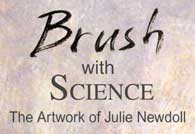

Recently Published Commissions.Doing a commission of scientific subjects leads to paintings of greatly expanded thought and design. Julie encourages scientists to invite her to do a portrait of their science. In addition to her traditional way of working, she has begun to explore placing scientific images and structures into the symbolic world of her paintings.
 View Portfolio |
 Inside Time |
 Shows |
 About/Contact the Artist |
The Descent of Ishtar into the Underworld through the Ancient Gates of an Aquaporin Glycerol Channel33” x 44”, 2000. Private Collection
Prints available
Ishtar was a goddess in the times when dreams were just as important as the waking reality; prophetic and real. Her story is revealed to us on clay tablets(1), the earliest version from around 1,600 B.C, unearthed in modern day Iraq. Written in cuniform, the oldest known written language, her ancient story presented itself to me during my search for an analogy between a most ancient biological gate and a mythological counterpart. This biological gate is found in membrane proteins that allow only water or glycerol to cross the membrane and enter a cell, and has been conserved for over four billion years.
A small handful of amino acids compose this gatekeeping system, and every species which contains a protein for conducting water or glycerol into a cell also contains this gateway package of amino acids. The first structure to be determined for this kind of channel was for a protein called the GLPF receptor (glycerol facilitator protein)(2). This protein is represented here, where the pillars of the channel in the painting mimic the arrangement of the seven helices which compose the GLPF receptor, with two of the helices stripped away to reveal the inside of the channel. The stairway portrays the connections between the helices that allow specific molecules to enter the channel, and the ancient gate is shown in its amino acid structure on the stairway.
In the Ishtar story, her descent into the underworld is strikingly enzymatic. She must pass through seven doors, losing a piece of clothing at each door, until she arrives naked into the underworld. Glycerol is like food for a bacteria, and once it passes through the gates of the GLPF receptor, it enters the cell to be broken down and digested into its various components. Ishtar descends the staircase and passes through the gates to enter the underworld using the same route a glycerol molecule would travel through this structure.
(1) “Myths from Mesopotamia, Creation, The Flood, Gilgamesh and Others”, by Stephanie Dalley, 1989, Oxford University Press, ISBN 0-19-283589-0
(2) “Structure of a glycerol-conducting channel and the basis for its selectivity”, Science, 2000 Oct 20;290(5491):481-6 . Fu D, Libson A, Miercke LJ, Weitzman C, Nollert P, Krucinski J, Stroud RM.
Cover of "Public Library of Science" Journal, December 2003, digital painting. Prints available
The cover depicts the structure of the newly-discovered, water-selective aquaporin AqpZ. Like its relative in the "Ishtar. . ." painting above, this protein is a membrane protein. It controls the flow of water into a cell. Five water molecules are seen in the channel defining the conductance pathway.
This painting is a bit of a departure from the other paintings displayed on the rest of this web site. Using the symbolism I have developed for my other paintings, I have placed a scientific representation of the AqpZ protein into a conceptual world. The protein is now in the same mythical surrounding which is depicted in the Ishtar painting above, but the rest of the Ishtar story has been replaced with an actual aquaporin structure. In addition to relating the new protein structure to its glycerol channel cousin, I am using the symbolic language of art to explore the properties of a cell and its surroundings; the calm internal blue-green of the membrane; the rough exterior surface of the membrane; the hot bed of activity inside of the cell and the approaching storm bringing water outside the cell; the ancient origins of our cellular systems.
Commission by Dr. Robert Stroud, UCSF. Journal article Architecture and Selectivity in Aquaporins: 2.5 Å X-Ray Structure of Aquaporin Z, David F. Savage, Pascal F. Egea, Yaneth Robles-Colmenares, Joseph D. O'Connell III, Robert M. Stroud. PLOS Volume 1, Issue 3, December 2003.
Cover of "Structure" Journal, July 2004, Private Collection Prints available without text
On the cover: The obese Greek god Silenus contemplating the crystal structure of the lipid droplet protein TIP47. TIP47 contains a hydrophobic pocket that is conserved in the adipocyte lipid droplet protein, perilipin. Perilipin and its hydrophobic pocket are potential targets for anti-obesity drug design.
Structure of a Lipid Droplet Protein: The PAT Family Member TIP47
Sabrina J. Hickenbottom 1, Alan R. Kimmel 1, ConstantineLondos 1, and James H. Hurley. Structure, Vol 12, 1199-1207, July 2004
Full Page Back Cover of
Folha De S.Paulo,
September 26, 2004
"The Transportation of Gilgamesh through an Ammonia Channel Into
the Garden of the Gods"
The ammonia channel is one of the most ancient proteins conserved among
species. The story of Gilgamesh is the oldest written story that we know of,
found on clay tablets written somewhere around 2750 and 2500 BCE.
In his search for everlasting life, Gilgamesh comes to
Mashu "the great mountain, which guards the rising and setting
sun," represented here by the Ammonia Channel AmtB. The tunnel
to the underworld is guarded by two scorpions. These are placed in
the entrance and exit to the channel of the
protein, allowing only Ammonia to pass through*. Gilgamesh arrives,
symbolizing the ammonium ion. He is transformed into ammonia and allowed to pass through.
Once on the other side he becomes himself again - the ammonium ion - and enters the rich world of cellular metabolism,
where ammonia first played a key role in the origin of life.Commission based on paper "Mechanism of ammonia transport by Amt/MEP/Rh: structure of AmtB at 1.35 A.", Khademi S, O'Connell J 3rd, Remis J, Robles-Colmenares Y, Miercke LJ, Stroud RM, Science. 2004 Sep 10;305(5690):1573-4.